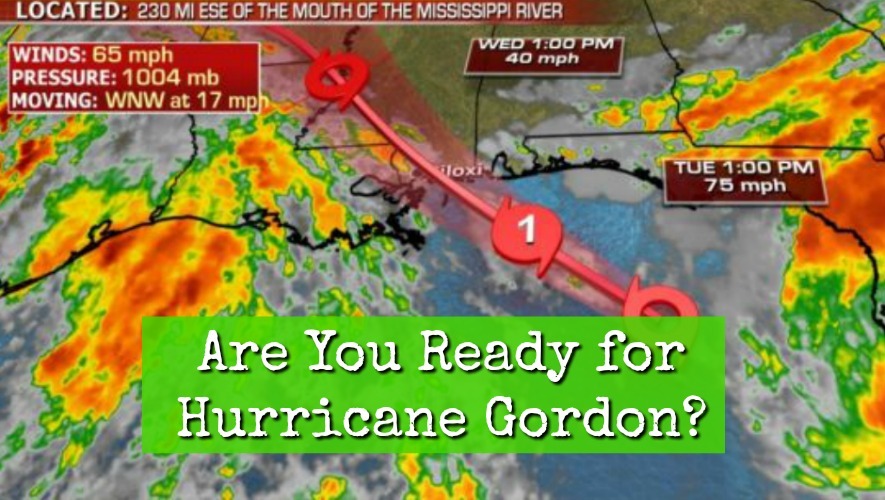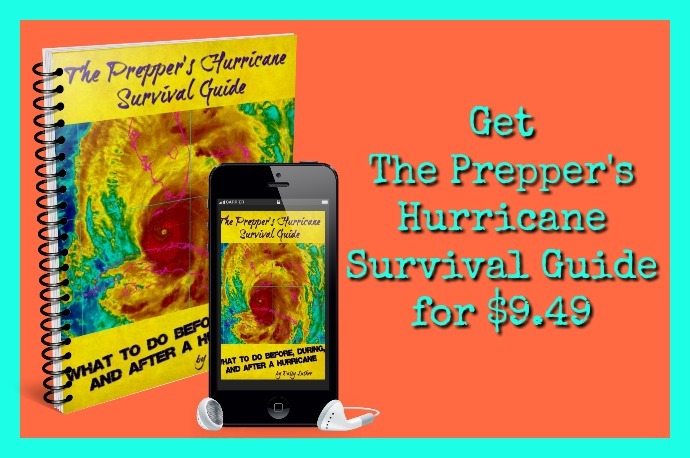If you're new here, you may want to subscribe to my RSS feed. Thanks for visiting!
Author of Be Ready for Anything and Bloom Where You’re Planted online course
Tonight, Tropical Storm Gordon will evolve into Hurricane Gordon and hit the Gulf Coast. The storm will “only” be a Category 1 if the weathermen are right, but does that mean you shouldn’t be concerned?
Yes and no.
The real danger is underestimating the storm
Obviously, 70 mph winds won’t do the same amount as damage that 140 mph winds will do, but 70 mph winds are still nothing to mess around with.
Despite the fact that Gordon is “only” a Category 1, you need to do the basics to get your home ready and be prepared for a power outage ranging from a few hours to a few days. As well, there is the threat of storm-driven flooding.
Voluntary evacuation orders were issued on Monday for parts of Louisiana for residents in areas outside the levee protection system. Gov. John Bel Edwards declared a state of emergency Monday and said 200 National Guard troops will be deployed to southeastern Louisiana…
…The National Hurricane Center reported that the storm could unleash “life-threatening” storm surge to portions of the central Gulf Coast. A storm surge warning has been issued for the area stretching from Shell Beach, Louisiana, to Dauphin Island, Alabama. The warning means there is danger of life-threatening inundation. The region could see rising waters of 3 to 5 feet.
“The deepest water will occur along the immediate coast near and to the east of the landfall location, where the surge will be accompanied by large waves,” the center said. (source)
While Gordon is highly unlikely to cause destruction like Maria and Harvey, people near the coast would still be wise to consider evacuating, or at the very least, preparing for significant flooding.
[thrive_link color=’orange’ link=’https://sowl.co/7l0QI’ target=’_blank’ size=’medium’ align=’aligncenter’]BUY NOW[/thrive_link]
Where will Hurricane Gordon strike?
It isn’t only coastal regions that can expect high winds, heavy rain, and potential flooding.
The storm’s turbulent center is expected to plow a path from the southwest corner of Alabama and central Mississippi into part of Louisiana and southern Arkansas.
Early Tuesday, Gordon was moving west-northwest at 17 mph, the National Hurricane Center said.
After it makes landfall, the storm is predicted to rapidly lose force. But forecasters warn that flash floods could be triggered by heavy rainfall from the western Florida Panhandle to Louisiana, with 4-8 inches predicted in many areas. Isolated areas could see up to 12 inches of rain, the weather service says.
Gordon is expected to slow its forward motion as it nears the coast, possibly adding to its rainfall totals in the region. (source)
So, although Hurricane Gordon will lose power as soon as it hits the coast if you are in Florida, Louisiana, Alabama, Mississippi, or Arkansas, you need to consider prepping for this storm.
How do you prep for a Category 1 hurricane?
You prep for a lower category hurricane in the same way you would a stronger one.
- Consider whether you need to evacuate.
- Secure things outside that could become projectiles in heavy winds.
- If you’re in a flood zone, move items to higher floors or attics.
- Set up a safe place in your home to wait out the storm, away from windows and not in a room under large trees.
- Stock up on enough water to last for up to a week in the event municipal supplies are contaminated. If your area is out of bottled water, you can begin filling all the containers you have at your home with tap water.
- Have enough food that doesn’t need to be cooked to last your family for several days up to a week in case you end up stranded.
- Make a plan for the potential of a power outage, including what to do about the items in your refrigerator and freezer.
- Get batteries, flashlights, and radios.
- Charge cell phones, battery packs, and other devices.
Just because Hurricane Gordon is “only” a Category 1 doesn’t mean you should overlook the importance of preparing. Hopefully, you already have supplies like food and water in place.
If you aren’t as prepared as you should be, you can get my PDF book, The Prepper’s Hurricane Survival Guide, right here.
[thrive_link color=’orange’ link=’https://sowl.co/7l0QI’ target=’_blank’ size=’medium’ align=’aligncenter’]Order The Prepper’s Hurricane Survival Guide for $9.49[/thrive_link]
It’s delivered digitally so you can read it immediately. It even contains a guide for last minute preparations when you can’t find supplies at the stores, which is a good thing since Gordon is due to land tonight. You can save it to a device, and/or print off the sections you need.
Be sure you have everything you need on hand and that you have accomplished the necessary tasks to keep your home safe and secure. You only have a few hours if you live in the area that Gordon is heading toward.

















2 Responses
In the early 2000’s I went through a “mere” Cat 1 hurricane. That mere Cat 1 ruined the neighborhood I was living in; the houses were later condemned and everyone had to move out. I was never so glad in my life to be a renter. We had no power for about 10 days and several people in the neighborhood proceeded to burn down their own homes by using candles for light. What amazed me most was that I, a person living alone, was the only person in the neighborhood with stored food and water. I was surrounded by married couples who had not stored any food or water for their children, even though we had a week’s warning of this hurricane’s approach, and they had to use a soup kitchen set up by a charity. You can bet I kept my mouth shut and acted as helpless and shiftless as everyone else for fear the neighbors would invade my home and take my food and water.
I have lived thru 6 or 7 hurricanes, 3 of which were in Florida. Our preps include the usually food and water for people and animals, batteries for lights and lanterns, radios and DVD players, extra gas for the generator, but also included ply wood covers for the windows which were reused for the next storms. We also tied down our outdoor shed to keep it from blowing away. About 12″ of water was always let out of the pool, the french drains cleaned and sandbags filled in case the storm stalled and rain flooded our area. The outdoor furniture cushions were moved to the garage and the furniture put in the pool. Of course most everyone in hurricane land has a roof tarp and 1″x2″x8′ wood strips to hold the tarp on if the roof gets damaged. If you can get the tarp on as soon as there’s a break in the wind, it will save the interior of your house.